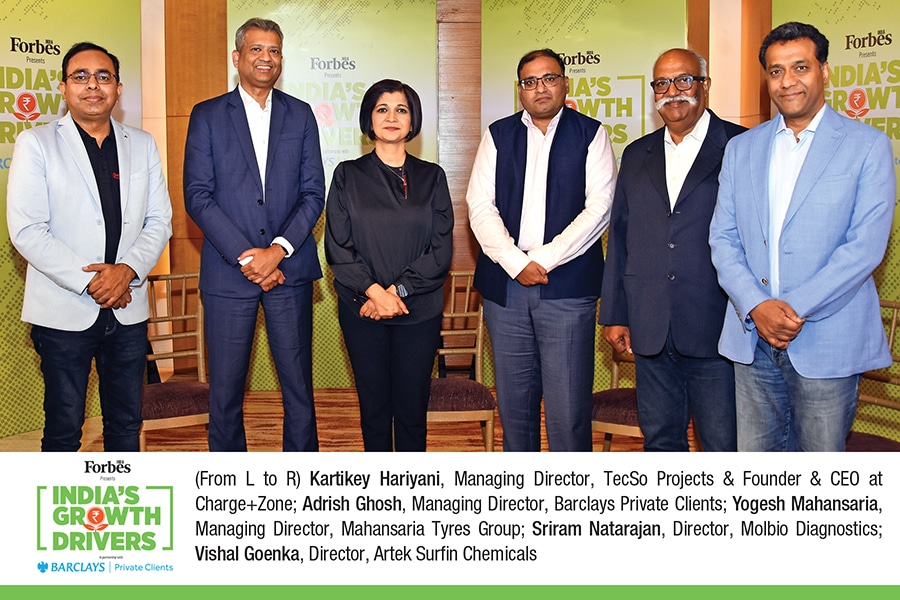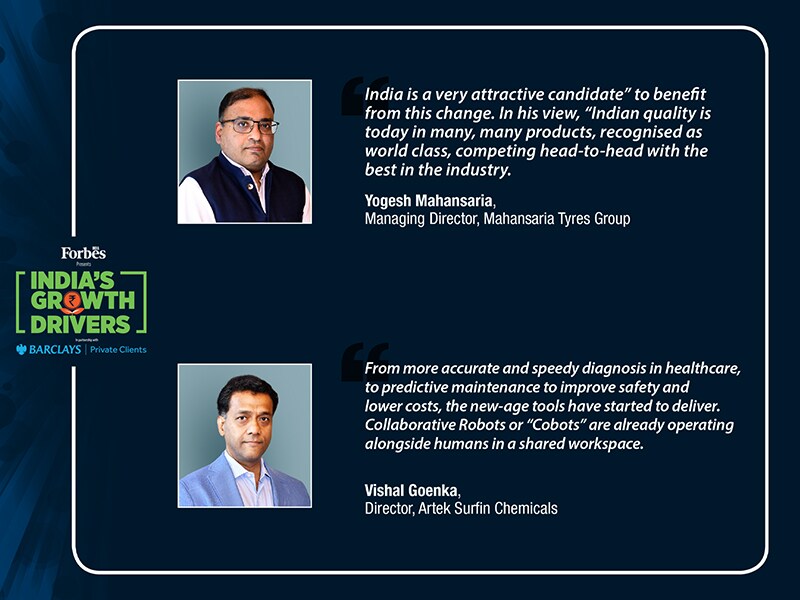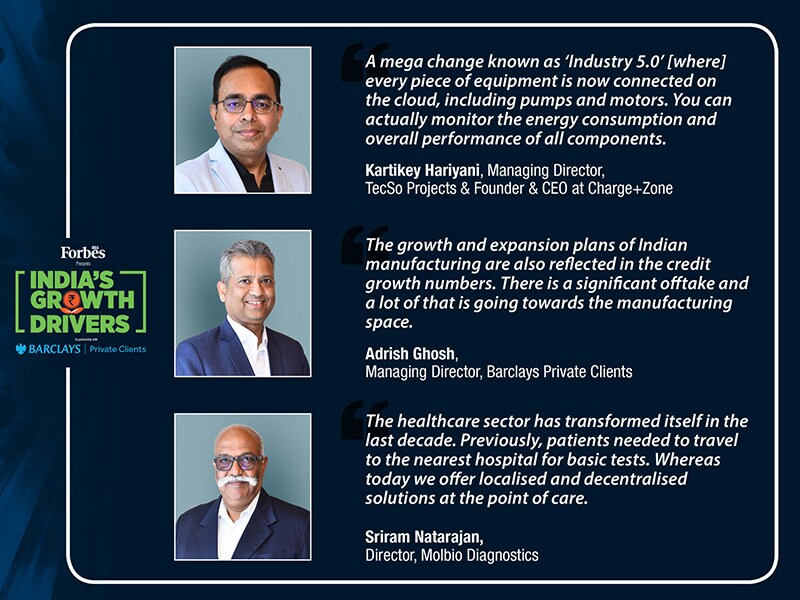India's manufacturing marvel: The drive for innovation and competitiveness
How India's manufacturing industry is aiming high through disruptive innovation


 Few big economies have managed to grow as fast as India despite the impact of the pandemic, rising global inflation, sluggish domestic demand and a prolonged war in Ukraine.
Few big economies have managed to grow as fast as India despite the impact of the pandemic, rising global inflation, sluggish domestic demand and a prolonged war in Ukraine.
At the current growth rate, the International Monetary Fund’s World Economic Outlook estimates that India’s GDP will surpass $5 trillion in 2026-27.
The manufacturing sector will play a crucial role in helping it get there. It accounts for around 15-17% of GDP, employs around 50-60 million people and is increasingly embracing innovative practices to help India compete as a global manufacturing hub.
In our “India’s Growth Drivers" series, Forbes India has partnered with Barclays Private Clients to explore the fundamental factors driving the remarkable growth narrative of India.
In the second of three panel discussions, industry leaders shared their views on the challenges and opportunities facing domestic manufacturing, and the sector’s vital role as a catalyst for India’s future growth.
Global opportunities complementing localisation drive in India
As countries around the world diversify their supply chains away from China to reduce dependency on the country, Yogesh Mahansaria, the Founder and Managing Director of Mahansaria Tyres Group, opined that “India is a very attractive candidate" to benefit from this change. In his view, “Indian quality is today in many, many products, recognised as world class, competing head-to-head with the best in the industry."
Some industries like the automotive sector have seen more disruption than others. Kartikey Hariyani, Managing Director at TecSo Projects & Founder and CEO at Charge+Zone, spoke about “a mega change known as ‘Industry 5.0’ [where] every piece of equipment is now connected on the cloud, including pumps and motors. You can actually monitor the energy consumption and overall performance of all components." “It is not about survival, it is change or perish" he added when commenting on disruptions like electric vehicles.
This offers a unique opportunity for Indian players to harness new technologies and manufacture in-house. “There is a lot of push for localisation, which is really good for the domestic market and the Indian economy", he added.
“Similarly, the healthcare sector has transformed itself in the last decade. Previously, whereas patients needed to travel to the nearest hospital for basic tests", said Sriram Natarajan Director, Molbio Diagnostics, “today we offer localised and decentralised solutions at the point of care".

Disruptive innovation is here to stay
Such rapid growth at scale will be a function of “disruptive innovation", reflected Mr Natarajan. Thus, innovation can be driven through “changing manufacturing methods and deployment strategy", added Mr Hariyani. He later offered the example of unmanned EV charging stations and batteries which can be remotely maintained and repaired after adequate diagnosis.
Not only are these shifts indicative of technological transformation, but also of mindset transformation. For a long time, the global manufacturing industry “was all about China plus one, now it is a China-minus strategy", according to Vishal Goenka, Director at Artek Surfin Chemicals.
He credited the government’s Production Led Incentive (PLI) Scheme which has activated “Made in India" on the ground. “GST reforms and reform in tax rates", too, have contributed to the industry’s fast-paced growth, opined Adrish Ghosh, Managing Director at Barclays Private Clients, India. While agreeing with Mr. Mahansaria’s views that a China scale model may not suit India, he also agreed with Mr. Hariyani’s remarks that: “The job of government is governance, policy making and framework. It is the job of the industry, entrepreneurs, and others to scale it up."
The growth and expansion plans of Indian manufacturing are also reflected in the credit growth numbers. “There is a significant offtake and a lot of that is going towards the manufacturing space", said Mr Ghosh. More crucially, he observed that “there’s a lot of investment going into digital" which will further galvanise the industry.
For instance, Artificial Intelligence, machine learning, Robotic Process Automation (RPA) and a host of other technologies have already shaken-up many sectors. From more accurate and speedy diagnosis in healthcare, to predictive maintenance to improve safety and lower costs, the new-age tools have started to deliver. Collaborative Robots or “Cobots" are already operating alongside humans in a shared workspace, observed Mr Goenka.

The path to sustainable growth
All panellists agreed that profitable growth cannot come at the cost of sustainability. The importance of “saving power, using renewable sources of energy, ensuring your staff are all being properly taken care of medically", said Mr Natarajan, cannot be overstated. “In fact, such an ESG approach helps to improve an organisation’s efficiency by ensuring cost-effective solutions, especially for global rollouts."
“I think today it"s very important for every business to be profitable, but also to do good", reflected Mr Mahansaria. “Any progressive business will find that you can actually do good for the environment and for your bottom line at the same time".
Mr Ghosh echoed the sentiments of the panel when he said that “investment in sustainability is not driven by the fact that they need to tick the box. It"s more driven by what makes sense for the businesses."
In conclusion, India"s remarkable economic growth amidst global challenges reflects its potential as a manufacturing powerhouse. Embracing disruptive innovation, localising production, and prioritising sustainability are the key drivers for future success. Government initiatives like the PLI Scheme, and industry leaders" commitment to balance profitability with environmental and social responsibility, will play pivotal roles in India"s journey to $5 trillion GDP and beyond.
The pages slugged ‘Brand Connect’ are equivalent to advertisements and are not written and produced by Forbes India journalists.
First Published: Sep 22, 2023, 11:09
Subscribe Now